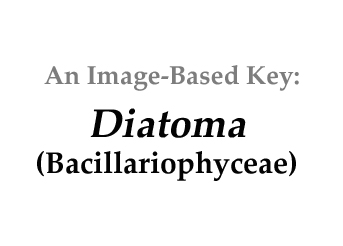|
|
||||
|
Click
on images for larger format |
||||
Name derivation: |
||||
|
Greek dia meaning
throughout toma meaning a slice
or a cut. |
||||
Classification: |
||||
Diatoma Bory de St-Vincent 1824; 23 of 228 species descriptions are currently accepted taxonomically (Guiry and Guiry 2014).Order Fragilariales; Family Fragilariaceae |
||||
Morphology: |
||||
|
Valve view is elliptical to elongated and can have rounded swollen ends. Distinct silicious striations or "bars" are present
across the valve. There is one narrow, central sternum that curves out at
each end. In girdle view the cells are rectangular to oblong. The cells
generally join in zig-zag colonies, but some
species are found as single cells. Cyclomorphosis
– predictable seasonal change in shape – includes longer and thinner cells
with maximum surface area to volume ratio during season of best growth
(May-June in the Baltic Sea). Sexual
reproduction occurred during the winter when cells were 30– 40% of maxium size. Cell
length (apical axis) varied from 3 to 80 μm during the three year study
(Potapova and Snoeijs
1997).
Seasonal changes in surface area to
volume ratio (S/V) in the southern Baltic Sea (closed circles) and in the
heated discharge from a nuclear electrical generating station (open circles)
with a similar pattern dominated by seasonal factors (light, nutrient
concentration) rather than higher temperature and water flow Potapova and Snoeijs 1997). |
||||
Similar genera: |
||||
|
|
||||
Phosphate and Silicate Kinetics: |
||||
|
Diatoma elongatum utilizes ‘luxurious consumption’ by storing up to 28 times more
phosphate and 4.4 times more silicate than needed, based on studies from a
population in Lake Michigan Canada-USA.
Half-saturation constants for growth were 0.02 µM PO4-P and
1.51 µM SiO2-Si (Kilham, Kott and Tilman 1977. |
||||
Habitat: |
||||
|
A strictly freshwater genus that can survive in some
slightly saline waters. |
||||
References: |
||||
|
Guiry, M.D. and G.M. Guiry 2013. AlgaeBase. World-wide electronic
publication, National University of Ireland, Galway. http://www.algaebase.org; searched on 22
May 2013. Kilham, S.S., C.L. Kott and D. Tilman 1977. Phosphate and silicate kinetics for the
Lake Michigan diatom Diatoma
elongatum. International Association of Great Lakes
Research 3(1-2):93-99. Potapova, M. and P. Snoeijs 1997. The natural life cycle in wild populations
of Diatoma moniliformis
(Bacillariophyceae) and its disruption in an
aberrant environment. Pournal of Phycology
33:924-937. Round, F. E., Crawford, R. M., Mann, D. G. 1990. The
Diatoms. Cambridge University Press. New York, NY. |
||||














